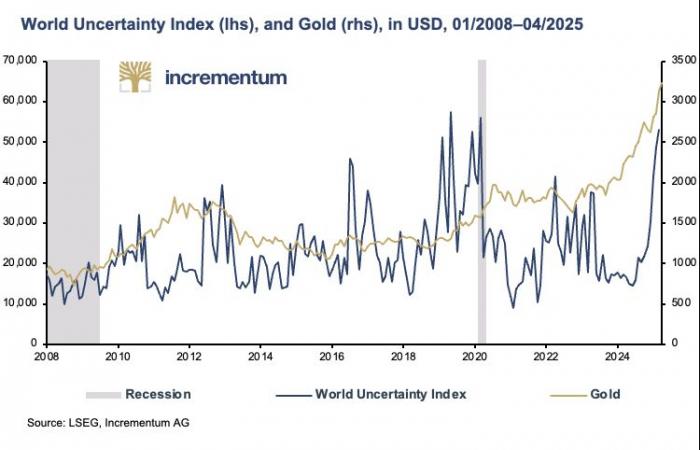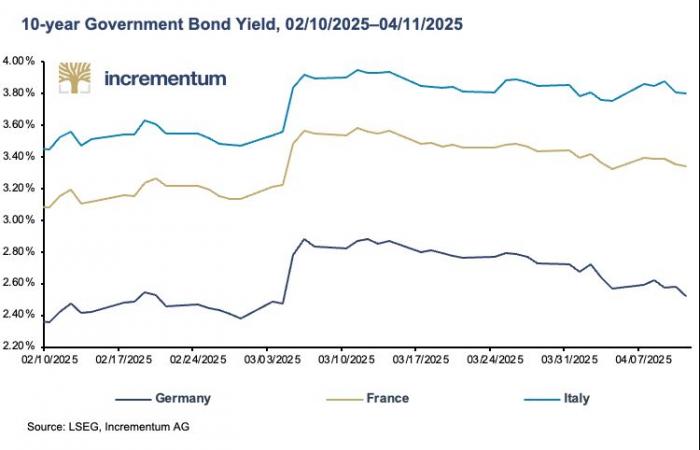A real shock has shaken the financial markets in the days following the Liberation daymarked by the application of customs duties on almost all countries of the world. Gold has established itself as one of the big winners: after a brief withdrawal under the $ 3,000, he crossed the $ 3,200 mark on April 11, then that of the $ 3,300 on April 16, thus reaching new historical heights. However, the strong depreciation of the US dollar – the dollar index fell by approximately 4% in a few days, by more than 4% compared to the euro and about 8% compared to the Swiss franc – made the price of gold in Euro has only increased slightly and fell by more than 4% in Swiss franc. For comparison, the S&P 500 plunged more than 7%.
One of the main reasons for the force of gold is its role of refuge value within portfolios, serving as protection against all forms of uncertainty, whether they are linked to armed conflicts, political crises or trade tensions. The positive correlation between the price of gold in US dollars and the World Uncertainty Index clearly testifies:

Another explanation is due to the displayed will of Donald Trump and his administration to considerably weaken the dollar. According to the dominant opinion in Washington, a strong dollar penalizes the American economy. However, the experience of the old Deutschemark block around Germany and Switzerland – the latter still today – shows that this argument does not resist the test of the facts. Be that as it may, the dollar is called upon to be strongly deemed in order to promote, in combination with customs duties, massive reindustrialisation of the United States, in accordance with the policy of “America first”.
In addition, the rumor of a possible “Mar-A-Lago agreement” circulates around the world, in reference to the two major monetary agreements of the 1980s: the Plaza agreement (1985) and the Louvre agreement (1987). Both had led to a devaluation of the US dollar. If the current balance of the United States had improved somewhat at the time, it had remained largely in deficit. It was only after the Louvre agreement that a significant reduction was recorded, even, in 1991, a slight punctual surplus. That said, thereafter, the current scale has become clearly negative again. It should be recalled that the main objective of the Louvre agreement was to end the depreciation of the dollar and to stabilize exchange rates between the main industrial economies in a target corridor. The precise structure of these target corridors had been set in an additional protocol, never made public.
The improvement of the current balance desired by the Trump administration-in other words, the reduction in the deficit in current accounts-would inevitably imply a decrease in capital flows to the United States. This would lead to a decline in demand for American financial assets, whether actions or bonds, thus losing a drop in their prices.
The United States discovered its golden treasure
As part of the discussions on the reorientation of internal, foreign, economic and commercial policy wanted by Donald Trump and his administration, the idea emerged that the United States could increase their significant gold reserves. Currently, the gold held by the American Treasury is registered in the balance sheet of the Federal Reserve in the form of a Gold certificate valued at only $ 42.22 per ounce – the price set in 1973 after the last official devaluation of the dollar compared to gold. A reassessment at the current price, around $ 3,000 per ounce, would allow the United States to generate around $ 800 billion in one time. A comparable operation had been carried out by Switzerland in 2000, when the BNS had achieved a revaluation gain of 28 billion CHF on its gold assets, which it had then redistributed to the cantons to finance tax cuts, some of which were substantial. However, the secretary of the Treasury, Scott Bessent, quickly ended speculation by dismissing this option.
Despite this rejection, the role of gold as a reference intake continues to gain momentum. The yellow metal gradually moves away from its outsider image, in particular because the values traditionally considered safe, such as state obligations – in particular the American treasury bills and German bunds – are increasingly under pressure, largely by their own fault.
Judy Shelton’s proposal for state bonds backed by gold
Judy Shelton offered another possible use of American gold reserves. Several years ago, that which is now envisaged as a possible successor by Jerome Powell at the head of the Federal Reserve – whose mandate expires in 2026 – presented its draft state obligations backed by gold. The plan is simple and is based on two pillars: the convertibility into gold and the revaluation of the current reserves of the United States, mentioned above. Certain emissions from the US Treasury, for example of a period of 50 years, would include an option allowing the holder of the obligation to buy it against a predetermined quantity of gold corresponding to $ 1,000 of nominal value.
Whether this plan sees the day or not, it is new proof that gold is perceived as a safe bet. He also confirms that gold is now considered a serious asset, capable of contributing to the resolution of major economic problems.
With his abdication as “King of debt” self -proclaimed, Donald Trump first surprised us by his words, then by his actions, in particular with the creation of the Doge under the direction of Elon Musk. In view of the current figures, it seems difficult to imagine that the objective of bringing the Washington deficit to 3% by 2028-as defined in the “Plan 3-3-3” by the current American secretary to the Treasury, Scott Bessent-is realistic. During the first half of the new fiscal year (October 2024 to March 2025), the US budget plunged back into bright red. The deficit amounted to $ 1,300 billion, an increase of more than 20% compared to the previous year, largely due to an increase in expenses of almost 10%.
Outside two years COVID-19, 2020 and 2021, the United States could register a budget deficit for the first time more than $ 2,000 billion. With a projected deficit of $ 1,900 billion, or 6.2% of GDP for the tax year ending in September, the current forecasts of the Congressional Budget Office (CBO) are barely below this critical threshold. For comparison, the deficit has reached an average of 3.8% of GDP in the past 50 years. The severity of the financial situation of the US federal budget is notably illustrated by the fact that in February, the monthly deficit ($ 306 billion) has exceeded Washington tax revenue ($ 296 billion). In other words, 51% of state spending for this month were funded by debt.
Germany abandons budgetary virtue
The fliedrich Merz’s flip-flop, winner of the Bundestag elections and now the designated Chancellor of Germany, was just as surprising-although in the opposite sense. Germany has suddenly moved away from its tradition of budgetary rigor by a double coup: the creation of a new special fund, which should rather be described as a special debt, in the amount of € 500 billion – including € 100 billion devoted to compulsory climate protection measures – as well as the relaxation of the brake to debt to finance defense expenses. In a single movement, German public debt has been increased by approximately a third.
What were the consequences of this historic violation of a campaign promise? The yields of German state bonds have jumped. At its peak, the yield of the German obligation at 10 years old has climbed more than 40 basic points, or 0.40 percentage points, to reach 2.93%. This represented an increase of almost 20% compared to its initial level. This is the strongest increase in German sovereign bonds for over 30 years. As a reference obligation, it has also led to an increase in yields in other countries, most of which are much more indebted. For France and Italy, the German turnaround will only increase an already tense debt situation.

The real question is whether, with this turnaround, Merz does not compromise the status of the German state obligation as a safe anchor of the fiduciary financial system. Be that as it may, gold remains an alternative experienced for centuries to fill the void thus created.
Conclusion
With the inauguration of Donald Trump, uncertainty linked to international policy, geopolitical dynamics and financial markets has increased considerably. It remains to be seen how long this phase of instability will last, in particular with the addition of the new factor that represents the erratic pricing policy of the United States. What is certain is that gold takes advantage of this rise in uncertainty. It is also indisputable that his role of neutral asset, without risk of consideration, is reinforced. Notable novelty: gold is rediscovered as an instrument of economic policy. Gold should also become even more attractive to investors due to volatility and weakness of the equity markets and bonds.
Reproduction, integral or partial, is authorized provided that it contains all hypertext links and a link to the original source.
The information contained in this article has a purely informative nature and in no way constitute an investment council or a recommendation for purchase or sale.
-









